Of Diwali Days Bygone – Part 1
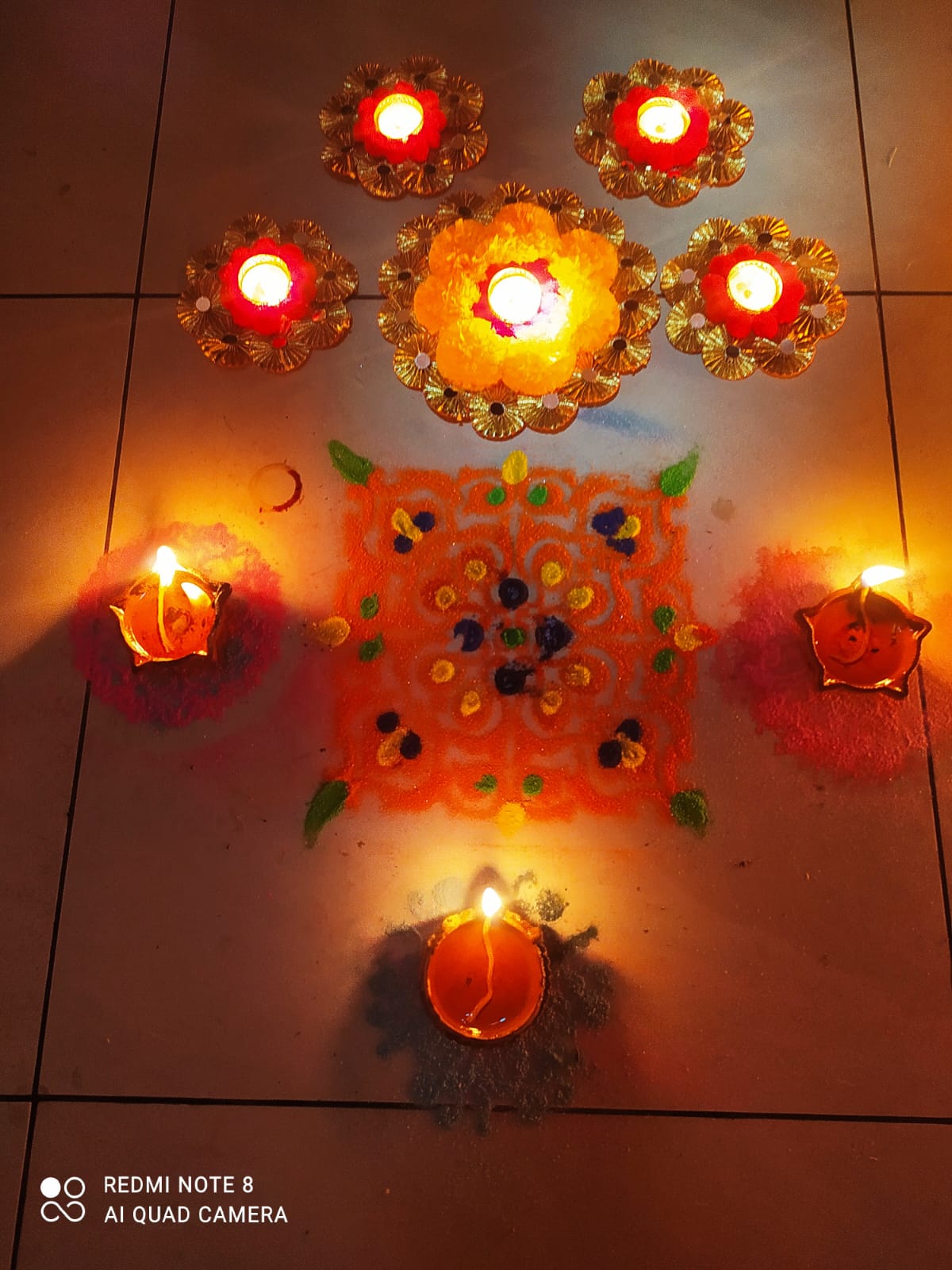
The aroma of roasted rice and an assortment of dals, or lentils, wafted upwards from the ‘uruli’, and gently the aromatic tendrils made their arduous journey towards us kids, tickling our olfactory senses teasingly. Mesmerized, I jumped up and shouted, ‘Yaay!’ Diwali is near!
Yes, as kids, we would know it’s Diwali when my mother and aunt – we lived as a joint family then – would start the preparations for the ‘Faral’, or Diwali sweets. The whole house would be awash with exotic aromas – initially, the roasting of ingredients like copra or dried coconut, peanuts, flours; new soaps bought for the ‘Abhyanga Snan’ on the second day of Diwali, Naraka Chaturdashi; the scintillating fragrance of ‘Kachooram’, or the rhizome of white ginger lily; the crisp freshness of new clothes… undoubtedly, Diwali was, and remains to this day, my most favorite festival; not just that – it’s my most favorite time of the year.
We didn’t have a whole lot of appliances in those days, simply because many were not invented, and some were not in common use, at least in my city. We did everything the old-fashioned way: sitting on the floor, frying the savory ‘chakli’ and the sweet ‘karanji’ in a big flat wok on a kerosene stove; feverishly rolling wicks out of my grandfather’s old cotton dhoties – the more the better, we wanted to light up the entire courtyard with the tiny clay lamps, a quintessential element of Diwali.
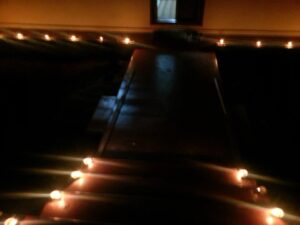
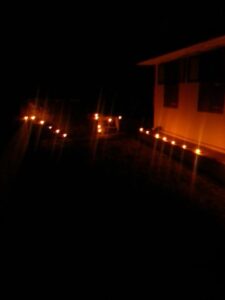
the entire courtyard lit up with diyas
The entire family would chip in – my father would be called upon for the muscle: the dough for the ‘Karanji’ needed to be pounded and smashed till it behaved, and it was Baba’s task each year, which he performed very nicely indeed with a granite grinding stone. My grandma would usually sit down to fry, my mother and aunt would be the chief chefs. The rest of us were mere minions, and we would all chip in, and of course, surreptitiously gulp down the moment the adults turned their attention away for a nanosecond. The Karanjis were the most complex, and time consuming to make, and required patience, and skill. The dough is made of refined flour, and it is rolled out into small roundels, then filled with a sweet mix of roasted copra, khus-khus (poppy seeds) and sugar, and the edges sealed, now shaped like a half moon. The edge is then cut with a decorative cutter, and the half moon is fried. Now don’t be fooled by the simple instructions here – this seemingly innocuous looking sweet has been the cause of many a rant from my mother and aunt, caused heartbreaks, and even a few hairs plucked out in frustration. The karanjis tend to break in the oil, spreading the stuffing all over, and causing a merry disturbance; sometime, they don’t get sealed properly and the stuffing pours into your hands when you pick it up; if it dries, it breaks; plus, whatever you cut off, you need to again roll out and fill – oh yes, it was an almost never ending process.
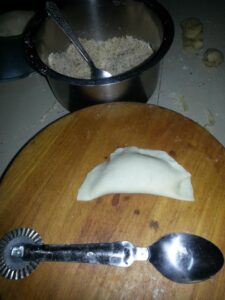
stuffed karanji waiting to be fried
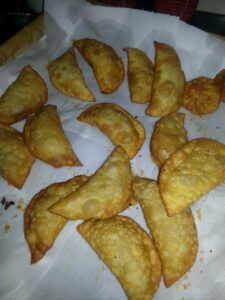
Fried karanji ready to eat
But it was also great fun; music would be played on the trusty ‘tape recorder’, or radio, and someone would make tea or get soft drinks for all the intrepid karanji makers. There would be non-stop talk, silly jokes, and raucous laughter, and endless tasting sessions. 2 to 3 tins would be filled with the stuff!
Other stuff we made never took up this much time or effort: besan (gram flour) laddoos, til (sesame) laddoos, rava (semolina) laddoos, Chakli – a multigrain fried savory, and Chivda – a mixture of fried beaten rice flakes or poha, peanuts, and spices.
Just preceding Diwali, or you could say it’s the first day of Diwali – is Vasu Baras. This day, a cow with calf is worshipped: she is garlanded, vermillion is applied on her forehead, and she is fed the ‘Faral’. We had cows at home, and it was always great excitement for us to bathe them and pamper them even more on this day.
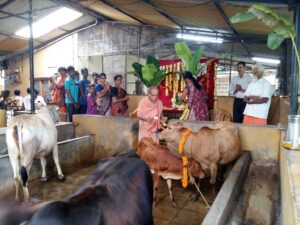
cows worshipped on Vasu Baras
Next is Dhana Trayodashi, considered an auspicious day to buy metal; my father used to buy small gold earrings for my mom, or sometimes we used to buy silver coins, or would buy some utensils needed in the kitchen. It was tradition that my father’s eldest sister and their family would stay with us for the entire 5 days of Diwali, and they would normally arrive on the evening of Dhana Trayodashi – this was a cause of great excitement for us kids, and we cousins would do everything to create as much of a racket as we could.
Naraka Chaturdashi! This was for us, the most important and exciting day of all. For, we had to get up really early, and finish bathing before morning broke. My father was in charge of waking up the entire household to make sure this target was achieved. He would get up at 3 am, have a cup of tea, and burst crackers that would ensure even the sleepiest family member would be sprung into wakefulness.
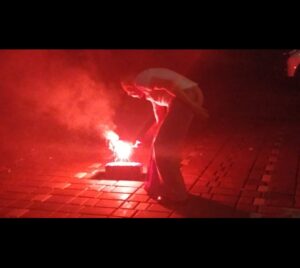
lighting firecrackers
In case anyone did not wake, we would go bang on their doors and almost drag them out, to light the diyas and light fireworks. Then my mom and aunt would start hollering for us to get inside and prepare for the Abhyanga Snan. Reluctantly, we would dispose of the sparklers, and wash our hands. We would sit on the floor, and the elder ladies would do ‘aarti’ for us, showing us a diya, applying tilak, and then the fragrant ground kachooram and coconut oil.

oil application for Abhyanga Snan
It used to be a race to the bathrooms to see who would finish first. New soaps were a must for the day, and I still remember the thrill of picking out our favourite colour of ‘Moti’ soap.

The tradition was to eat something sweet after the grand bathing – and we would run to the cupboard where the goodies were stored to grab our favourites; only to be sternly reprimanded by the ladies of the house. We had to be decent, and take it from the dishes laid out on the kitchen table.





